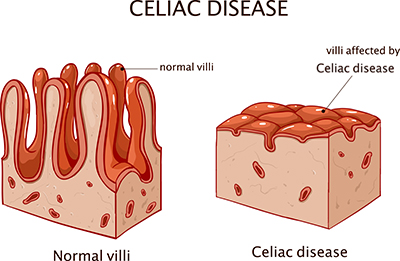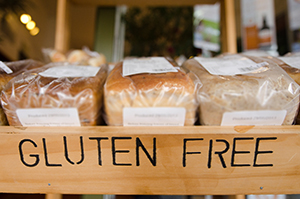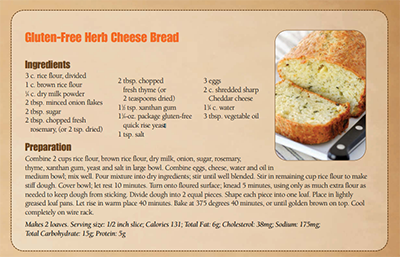Eating Gluten-Free
Fast Facts
- For most people, eating gluten free is a choice.
- One percent of the US population has celiac disease.
- For people who do not have celiac disease, gluten intolerance or gluten sensitivity, a gluten-free diet doesn’t provide any health benefit.
- Download our Eating Gluten-free Fact Sheet for more information and gluten-free recipes
What is gluten and why are people avoiding it?
Gluten is a term for proteins found in certain grains like wheat, barley, rye and
triticale (a wheatrye hybrid). When mixed with liquid and manipulated, the proteins
form an elastic substance that gives structure to flour mixtures such as bread.
When a person with celiac disease eats gluten, his/her immune system responds by attacking the lining of the small intestine. The small, fingerlike growths in the intestine, called villi, are damaged in the process (see image on the right) and are not able to absorb the important nutrients needed for health. This increases the risk for nutrient deficiency diseases like bone disease and anemia.
How many people suffer from celiac disease?
It is estimated that around 1 percent of the US population has celiac disease. Another 5 to 10 percent of the population may have some degree of gluten intolerance or sensitivity. Nonceliac gluten sensitivity does not result in damage to the digestive tract, but it can cause a range of uncomfortable symptoms similar to those of celiac disease.
What are the symptoms of celiac disease?
Symptoms of celiac disease include: stomach pain, gas, diarrhea, extreme tiredness, change in mood, slowed growth, itchy skin rash with blisters, and weight loss.
The only treatment for celiac disease is a gluten free diet. Avoiding gluten will allow the small intestine to heal. Eating foods that contain gluten will continue to harm the small intestine.
Will a gluten-free diet help you lose weight?
For people who do not have celiac disease, gluten intolerance or gluten sensitivity, a gluten-free diet doesn’t provide any health benefit. The whole grains that contain gluten are a good source of fiber, vitamins and minerals. People following gluten free diets may not get enough essential nutrients and may need to take supplements.
People who do not have celiac disease but follow a gluten free diet may lose weight
and feel better because they have cut out foods made with refined grains like desserts,
snack foods and other processed foods.
Naturally Gluten-free Foods
The following list provides examples of naturally gluten-free foods. This is not a complete list.
- Legumes
- Buckwheat
- Beans, plain
- Nuts
- Oils
- Corn
- Quinoa
- Dairy: plain
- Seeds
- Flax
- Sorghum
- Fresh eggs
- Soy
- Fresh fruits
- Fresh meats, poultry, fish
- Herbs
- Vegetables
Foods that Contain Gluten
- Wheat: including einkorn, emmer, spelt, kamut, wheat starch, wheat bran, wheat germ, cracked wheat, hydrolyzed wheat protein
- Triticale (a cross between wheat and rye)
- Barley
- Rye
Additional Information & Resources
There are multiple resources available for those with gluten sensitivity or celiac disease. These websites may be helpful in adapting to a gluten free diet.
www.americanceliacsociety.org
www.celiac.org
www.gluten.net
For smart phones users, there is also a new mobile app for gluten free eaters. The app is called The Gluten Detective can be used to identify gluten containing ingredients in food items at the grocery store.

